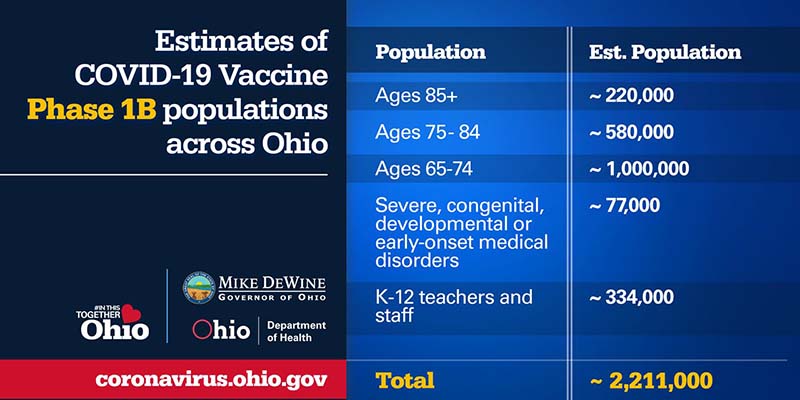
Governor DeWine today recapped Phases 1A and 1B of Ohio’s vaccine distribution plan. Because the availability of the vaccine remains limited in Ohio and across the country, Ohio is taking a phased approach that prioritizes the most vulnerable citizens, those in the healthcare field, and school staff members.
Phase 1A, which is currently underway, includes approximately 1 million Ohioans. It is anticipated that vaccine distribution in Phase 1B will begin as Phase 1A begins to wind down.
Phase 1B focuses largely on those who are 65 and older. Those in this age group are most vulnerable to COVID-19 and make up more than 87 percent of Ohioans who have died from the virus. Phase 1B also includes school teachers and other school staff who will be offered the vaccine in an effort to get Ohio’s children back to school as soon as possible. In total, Phase 1B includes an estimated 2.2 million people.
Details of future phases of the vaccination plan will be announced as Phases 1A and 1B progress and as Ohio receives vaccines for the future phases. Ohio is currently receiving roughly 100,000 vaccines each week, although that number could increase if more vaccines are approved for administration.
NURSING HOME VACCINATIONS
As of Sunday, approximately 61 percent of nursing homes in Ohio have been visited by a pharmacy vaccine provider. Of those locations, only approximately 40 percent of staff members have chosen to receive the vaccination. Of nursing home residents, approximately 75 to 80 percent of residents have decided to receive the vaccine.
Nursing home staff and residents who have received their first dose of vaccine will begin receiving second doses on Friday. Governor DeWine encouraged those in nursing homes who initially declined to receive the vaccine to get their first dose as part of this second round. Following this opportunity, it may be some time before a first dose is available again.
VACCINE DISCUSSIONS FOR LONG-TERM CARE PROVIDERS
The Ohio Department of Aging will be hosting live discussions to help educate long-term care providers about the importance of the COVID-19 vaccine. State and community vaccine experts will be available to answer questions about the vaccine, and participants will have the opportunity to offer input to help state leaders make decisions to guide Ohio out of the pandemic.
VIRUS VARIANT
Dr. Bruce Vanderhoff, Chief Medical Officer for the Ohio Department of Health, provided information related to the coronavirus variation that was first seen in the United Kingdom.
“Although virus variations are normal, and most do not impact the behavior of a virus, this variation is notable because it appears to be more contagious than other variants of the coronavirus,” said Dr. Vanderhoff. “Fortunately, this variant doesn’t appear to be more severe or to impact those who are already immune, but it worries us because a more contagious variant could lead to more people getting sick, more people being hospitalized, and more people dying.”
Ohio currently has three times the number of COVID-19 hospitalizations that it had on November 1 and nearly seven times the number of COVID-19 hospitalizations that it had on October 1.
Dr. Vanderhoff stressed the importance of continuing Ohio’s coronavirus protocols of social distancing, avoiding crowds, washing hands, wearing masks, and accepting the vaccine when available to prevent the spread of all variants of the coronavirus and to prevent further increases in hospitalizations.
VACCINE REDISTRIBUTION PLANS
The Ohio Department of Health will be issuing a directive requiring vaccine providers to develop a surplus vaccine redistribution plan. The directive follows a recent incident in which a long-term care facility in Ohio overestimated the number of vaccine doses needed for residents and staff. Seven vials of vaccine (35 doses) were not administered and expired.
“Every vaccine dose that Ohio receives must be administered,” said Governor DeWine. “Each vaccine represents a potential life saved, and it is our obligation to ensure that not a single dose is wasted.”
Vaccine redistribution plans will prioritize recipients based on Phase 1A and 1B vaccine distribution criteria. If a significant number of doses remain, vaccine providers must contact the Ohio Department of Health for immediate redistribution assistance.
CURRENT CASE DATA
In total, there are 735,003 confirmed and probable cases of COVID-19 reported in Ohio and 9,247 confirmed and probable COVID-19 deaths. A total of 39,650 people have been hospitalized throughout the pandemic, including 6,022 admissions to intensive care units. In-depth data can be accessed by visiting coronavirus.ohio.gov.
Video of today’s full update, including versions with foreign language translation, can be viewed on the Ohio Channel’s YouTube page.
For more information on Ohio’s response to COVID-19, visit coronavirus.ohio.gov or call 1-833-4-ASK-ODH.
